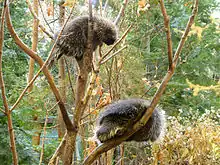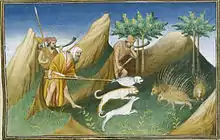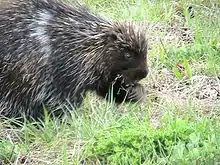Porcupine
Porcupine are large rodents with coats of sharp and pointy spines, or quills, that protect them against predators. The term covers two families of animals: the Old World porcupines of family Hystricidae, and the New World porcupines of family Erethizontidae. Both families belong to the infraorder Hystricognathi within the profoundly diverse order Rodentia and display superficially similar coats of quills. Despite this, the two groups are distinct from one another and are not closely related to each other within the Hystricognathi. It is the third largest living rodent in the world after the capybara and beaver.
| Porcupine | |
|---|---|
 | |
| North American porcupine | |
| Scientific classification | |
| Kingdom: | Animalia |
| Phylum: | Chordata |
| Class: | Mammalia |
| Order: | Rodentia |
| Suborder: | Hystricomorpha |
| Infraorder: | Hystricognathi |
| Groups included | |
| |
| Cladistically included but traditionally excluded taxa | |
| |
The Old World porcupines live in southern Europe, Asia (western[1] and southern), and most of Africa. They are large, terrestrial, and strictly nocturnal. In taxonomic terms, they form the family Hystricidae.
The New World porcupines are indigenous to North America and northern South America. They live in wooded areas and can climb trees, where some species spend their entire lives. They are less strictly nocturnal than their Old World relatives, and generally smaller. In taxonomic terms, they form the family Erethizontidae.
Most porcupines are about 60–90 cm (25–36 in) long, with a 20–25 cm (8–10 in) long tail. Weighing 5–16 kg (12–35 lb), they are rounded, large, and slow, and use aposematic strategy of defence. Porcupines occur in various shades of brown, grey and white. Porcupines' spiny protection resembles that of the unrelated erinaceomorph hedgehogs and Australian monotreme echidnas as well as tenrecid tenrecs.
Etymology
The word "porcupine" comes from Latin porcus pig + spina spine, quill, via Old Italian (Italian "porcospino", thorn-pig)—Middle French—Middle English.[2][3] A regional American name for the animal is "quill-pig".[4]
Evolution
Fossils belonging to the genus Hystrix date back to the late Miocene of the continent of Africa.[5]
Species
Taxonomy
A porcupine is any of 58 species of rodents belonging to the families Erethizontidae (genera: Coendou, Erethizon, and Chaetomys) or Hystricidae (genera: Atherurus, Hystrix, and Trichys). Porcupines vary in size considerably: Rothschild's porcupine of South America weighs less than a kilogram (2.2 lb); the crested porcupine found in Italy, North Africa, and sub-Saharan Africa can grow to well over 27 kg (60 lb). The two families of porcupines are quite different, and although both belong to the Hystricognathi branch of the vast order Rodentia, they are not closely related.
Old World compared with New World species
The 11 Old World porcupines tend to be fairly large, and have spikes grouped in clusters.
The two subfamilies of New World porcupines are mostly smaller (although the North American porcupine reaches about 85 cm or 33 in in length and 18 kg or 40 lb), have their quills attached singly rather than grouped in clusters, and are excellent climbers, spending much of their time in trees. The New World porcupines evolved their spines independently (through convergent evolution) and are more closely related to several other families of rodents than they are to the Old World porcupines.
Longevity
Porcupines have a relatively high longevity and have held the record for being the longest-living rodent, with one individual living to 27 years,[6] until the record was broken in 2002 by a naked mole-rat living to 28 years.[7]
Diet
The North American porcupine is an herbivore; it eats leaves, herbs, twigs, and green plants such as clover. In the winter, it may eat bark. It often climbs trees to find food.[8]
The African porcupine is not a climber and forages on the ground.[8] It is mostly nocturnal,[9] but will sometimes forage for food in the day, eating bark, roots, fruits and berries, as well as farm crops. Porcupines have become a pest in Kenya and are eaten as a delicacy.[10]
Defense
Defensive behaviour displays in a porcupine depend on sight, scent and sound. Often, these displays are shown when a porcupine becomes agitated or annoyed. There are four main displays seen in a porcupine which are quill erection, teeth clattering, emitting of odour, and attack.[11] These displays are ranked from least aggressive to most aggressive respectively. A porcupine's colouring aids in part of its defence as most of the predators are nocturnal and colour blind. A porcupine's markings are black and white. The dark body and coarse hair of the porcupine are a dark brown/black and when quills are raised, present a white strip down its back mimicking the look of a skunk. This, along with the raising of the sharp quills, deters predators. Along with the raising of the quills, porcupines clatter their teeth causing warning noise to let predators know not to come closer. The incisors vibrate against each other, the strike zone shifts back and the cheek teeth clatter. This behaviour is often paired with body shivering which is used to further display the dangerous quills.[11] The rattling of quills is aided by the hollow quills at the back end of the porcupine.[12] The use of odor is when the sight and sound have failed. An invasive scent is produced from the skin above the tail in times of stress, and is often seen with quill erection.[13] If the above processes fail, the porcupine will attack by running sideways or backwards into predators. A porcupine's tail is also able to swing in the direction of the predator. If contact is made, the quills could be impaled into the predator causing injury or death.[14]
Quills

Porcupines' quills, or spines, take on various forms, depending on the species, but all are modified hairs coated with thick plates of keratin,[15] and embedded in the skin musculature. Old World porcupines have quills embedded in clusters, whereas in New World porcupines, single quills are interspersed with bristles, underfur, and hair.
Quills are released by contact or may drop out when the porcupine shakes its body. New quills grow to replace lost ones.[15][16] Porcupines were long believed to have the ability to project their quills to a considerable distance at an enemy, but this has since been proven to be untrue.[17][18]
There are some possible antibiotic properties within the quills, specifically associated with the free fatty acids coating the quills.[12] The antibiotic properties are believed to aid a porcupine that has suffered from self-injury.
Uses by humans

Porcupines are seldom eaten in Western culture, but are very popular in Southeast Asia, particularly Vietnam, where the prominent use of them as a food source has contributed to significant declines in their populations.[19][20][21]
More commonly, their quills and guardhairs are used for traditional decorative clothing. For example, their guardhairs are used in the creation of the Native American "porky roach" headdress. The main quills may be dyed, and then applied in combination with thread to embellish leather accessories such as knife sheaths and leather bags. Lakota women would harvest the quills for quillwork by throwing a blanket over a porcupine and retrieving the quills it left stuck in the blanket.[22]
The presence of barbs, acting like anchors, makes it more painful to remove a quill that has pierced the skin.[15] The shape of the barbs makes the quills more effective, both for penetrating the skin and remaining in place.[23] The quills have inspired research for such applications as the design of hypodermic needles and surgical staples.[23][24] As opposed to the current design for surgical staples, the porcupine quill and barb design would allow for easy and painless insertion as the staple would stay in the skin using the anchored barb design rather than being bent under the skin like traditional staples.[24]
Habitat

Porcupines occupy a small range of habitats in tropical and temperate parts of Asia, Southern Europe, Africa, and North and South America. They live in forests and deserts, rocky outcrops, and hillsides. Some New World porcupines live in trees, but Old World porcupines stay on the rocks. Porcupines can be found on rocky areas up to 3,700 m (12,100 ft) high. They are generally nocturnal, but are occasionally active during daylight.

Classification

Porcupines are distributed into two evolutionarily independent groups within the suborder Hystricomorpha of the Rodentia.[25][26][27][28][29][30][31][32]
- Infraorder Hystricognathi
- Family Hystricidae: Old World porcupines
- African brush-tailed porcupine, Atherurus africanus
- Asiatic brush-tailed porcupine, Atherurus macrourus
- Crested porcupine, Hystrix cristata
- Cape porcupine, Hystrix africaeaustralis
- Indian porcupine, Hystrix indicus
- Malayan porcupine, Hystrix brachyura
- Himalayan porcupine, Hystrix (brachyura) hodgsoni
- Sunda porcupine, Hystrix javanica
- Sumatran porcupine, Hystrix (Thecurus) sumatrae
- Thick-spined porcupine, Hystrix (Thecurus) crassispinis
- Philippine porcupine, Hystrix (Thecurus) pumilis
- Long-tailed porcupine, Trichys fasciculata
- Parvorder Phiomorpha sensu stricto
- Family Thryonomyidae: cane rats
- Family Petromuridae: Dassie rats
- Family Bathyergidae: African mole-rats
- Parvorder Caviomorpha
- Superfamily Erethizontoidea
- Family Erethizontidae: New World porcupines
- Brazilian porcupine, Coendou prehensilis
- Bicolored-spined porcupine, Coendou bicolor
- Andean porcupine, Coendou quichua
- Black dwarf (Koopman's) porcupine, Coendou nycthemera (koopmani)
- Rothschild's porcupine, Coendou rothschildi
- Santa Marta porcupine, Coendou sanctemartae
- Mexican hairy dwarf porcupine, Coendou mexicanus
- Paraguaian hairy dwarf porcupine, Coendou spinosus
- Bahia porcupine, Coendou insidiosus
- Brown hairy dwarf porcupine, Coendou vestitus
- Streaked dwarf porcupine, Coendou ichillus
- Black-tailed hairy dwarf porcupine, Coendou melanurus
- Roosmalen's dwarf porcupine, Coendou roosmalenorum
- Frosted hairy dwarf porcupine, Coendou pruinosus
- Stump-tailed porcupine, Coendou rufescens
- North American porcupine, Erethizon dorsatum
- Bristle-spined porcupine, Chaetomys subspinosus (sometimes considered an echimyid)
- Family Erethizontidae: New World porcupines
- Superfamily Cavioidea
- Family Hydrochaeridae: capybara
- Family Caviidae: Guinea-pigs
- Family Dasyproctidae: agoutis and acouchis
- Superfamily Octodontoidea
- Family Abrocomidae: chinchilla-rats
- Family Octodontidae: degus
- Family Ctenomyidae: tuco-tucos
- Family Echimyidae: spiny rats
- Family Myocastoridae: nutrias
- Family Capromyidae: hutias
- Superfamily Chinchilloidea
- Family Chinchillidae: chinchillas and allies
- Family Dinomyidae: pacaranas
- Superfamily Erethizontoidea
- Family Hystricidae: Old World porcupines
See also
References
- Porcupine. biblehub.com
- Merriam-Webster Online Dictionary, s.v. "porcupine" . Retrieved March 26, 2015.
- Wedgwood, Hensleigh (1855). "On False Etymologies". Transactions of the Philological Society (6): 68.
- Oxford English Dictionary, s.v. "quill Archived 2012-04-25 at the Wayback Machine" . Retrieved July 20, 2010.
- Barthelmess, E.L. (2006). "Hystix africaeaustralis". Mammalian Species. 788 (788): 1–7. doi:10.1644/788.1.
- Parker, SB (1990) Grzimek's Encyclopedia of Mammals, vol. 4, McGraw-Hill, New York.
- Buffenstein, Rochelle; Jarvis, Jennifer U. M. (May 2002). "The naked mole rat—a new record for the oldest living rodent". Science of Aging Knowledge Environment. 2002 (21): 7pe–7. doi:10.1126/sageke.2002.21.pe7. PMID 14602989.
- "Porcupines, Porcupine Pictures, Porcupine Facts". National Geographic. 2010-09-10. Retrieved 2012-02-20.
- "North American porcupine – Erethizon dorsatum (Linnaeus, 1758)". Natural History Museum of Los Angeles County. Archived from the original on June 7, 2014. Retrieved July 26, 2012.
- "Porcupines raise thorny questions in Kenya". BBC News. August 19, 2005. Retrieved September 21, 2009.
- Roze, Uldis (2009). The North American Porcupine Second Edition (Second ed.). Cornell University, United States of America: Cornell University Press. ISBN 978-0-8014-4646-7.
- Roze, Locke, Uldis, David (March 1990). "Antibiotic Properties of Porcupine Quills". Journal of Chemical Ecology. 16 (3): 725–734. doi:10.1007/bf01016483. PMID 24263588.
- Guang, Li (1997). "Waring Odor of the North American Porcupine". Journal of Chemical Ecology. 23 (12): 2737–2754. Bibcode:1997JSP....23.2737L. doi:10.1023/a:1022511026529.
- Mori, Emiliano (October 2013). "The defense strategy of the crested porcupine Hystrix cristata". ResearchGate.
- David Attenborough (2014). Attenborough's Natural Curiosities 2. Armoured Animals. UKTV.
- "Porcupines | National Geographic". Animals. 2010-09-10. Retrieved 2019-04-16.
- Encyclopædia Britannica: Or, A Dictionary of Arts, Sciences, and Miscellaneous Literature, Enlarged and Improved. Archibald Constable. 1823. pp. 501–.
- Shepard, Thomas Goodwin (1865). The natural history of secession. Derby & Miller. pp. 78–.
- "Wild Southeast Asian porcupines under threat due to illegal hunting, researchers find". Sciencedaily.com. 2010-08-25. Retrieved 2012-02-20.
- Brooks, Emma G.E.; Roberton, Scott I.; Bell, Diana J. (2010). "The conservation impact of commercial wildlife farming of porcupines in Vietnam". Biological Conservation. 143 (11): 2808. doi:10.1016/j.biocon.2010.07.030.
- Ettinger, Powell (2010-08-30). "Wildlife Extra News – Illegal hunting threatens Vietnam's wild porcupines". Wildlifeextra.com. Retrieved 2012-02-20.
- "Lakota Quillwork Art and Legend". Retrieved 29 June 2013.
- Cho, W. K.; Ankrum, J. A.; Guo, D.; Chester, S. A.; Yang, S. Y.; Kashyap, A.; Campbell, G. A.; Wood, R. J.; Rijal, R. K.; et al. (2012). "Microstructured barbs on the North American porcupine quill enable easy tissue penetration and difficult removal". Proceedings of the National Academy of Sciences. 109 (52): 21289–94. Bibcode:2012PNAS..10921289C. doi:10.1073/pnas.1216441109. PMC 3535670. PMID 23236138.
- Porcupines Give You 30,000 Reasons to Back Off | Deep Look, retrieved 2020-05-14
- Huchon D., Catzeflis F. & Douzery E. J. P. (2000). "Variance of molecular datings, evolution of rodents, and the phylogenetic affinities between Ctenodactylidae and Hystricognathi". Proc. R. Soc. Lond. B. 267 (1441): 393–402. doi:10.1098/rspb.2000.1014. PMC 1690539. PMID 10722222.
- Murphy W. J.; Eizirik E.; Johnson W. E.; Zhang Y. P.; Ryder O. A.; O'Brien S. (2001). "Molecular phylogenetics and the origins of placental mammals". Nature. 409 (6820): 614–618. Bibcode:2001Natur.409..614M. doi:10.1038/35054550. PMID 11214319.
- Huchon D.; Chevret P.; Jordan U.; Kilpatrick C. W.; Ranwez V.; Jenkins P. D.; Brosius J.; Schmitz J. (2007). "Multiple molecular evidences for a living mammalian fossil". Proc. Natl. Acad. Sci. USA. 104 (18): 7495–7499. Bibcode:2007PNAS..104.7495H. doi:10.1073/pnas.0701289104. PMC 1863447. PMID 17452635.
- Blanga-Kanfi S.; Miranda H.; Penn O.; Pupko T.; DeBry R. W.; Huchon D. (2009). "Rodent phylogeny revised: analysis of six nuclear genes from all major rodent clades". BMC Evol. Biol. 9: 71. doi:10.1186/1471-2148-9-71. PMC 2674048. PMID 19341461.
- Churakov G.; Sadasivuni M. K.; Rosenbloom K. R.; Huchon D.; Brosius J.; Schmitz J. (2010). "Rodent evolution: back to the root". Mol. Biol. Evol. 27 (6): 1315–1326. doi:10.1093/molbev/msq019. PMID 20100942.
- Meredith R. W.; Janecka J. E.; Gatesy J.; Ryder O. A.; Fisher C. A.; Teeling E. C.; Goodbla A.; Eizirik E.; Simao T. L.; Stadler T.; Rabosky D. L.; Honeycutt R. L.; Flynn J. J.; Ingram C. M.; Steiner C.; Williams T. L.; Robinson T. J.; Burk-Herrick A.; Westerman M.; Ayoub N. A.; Springer M. S.; Murphy W. J. (2011). "Impacts of the Cretaceous terrestrial revolution and KPg extinction on mammal diversification". Science. 334 (6055): 521–524. Bibcode:2011Sci...334..521M. doi:10.1126/science.1211028. PMID 21940861.
- Fabre P.-H.; Hautier L.; Dimitrov D.; Douzery E. J. P. (2012). "A glimpse on the pattern of rodent diversification: a phylogenetic approach". BMC Evol. Biol. 12: 88. doi:10.1186/1471-2148-12-88. PMC 3532383. PMID 22697210.
- Upham N. S. & Patterson B. D. (2012). "Diversification and biogeography of the Neotropical caviomorph lineage Octodontoidea (Rodentia: Hystricognathi)". Mol. Phylogenet. Evol. 63 (2): 417–429. doi:10.1016/j.ympev.2012.01.020. PMID 22327013.
External links
| Wikimedia Commons has media related to Porcupines. |
- Wildlife Conservation: Porcupine African Wildlife Foundation
- "Resource Cards: What About Porcupines?" Pacific Northwest National Laboratory
- Porcupine control in the western states University of North Texas Digital Library
- The Complete Resource To Keeping Porcupines As Pets
